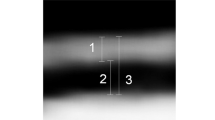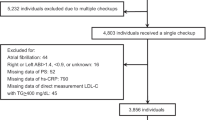Abstract
This study is to investigate the relationships between prevalent cardiovascular events (myocardial infarction, stroke and peripheral arterial disease) and carotid intima-media thickness (CIMT) in middle-aged and older adults; to assess which of the indexes, IMT in the common carotid artery (CCA), internal carotid artery (ICA) and carotid bifurcation (CB) separately or in combination, is a better correlate. IMT of the CCA, ICA and CB were measured with duplex ultrasound in 1058 individuals (aged between 37 and 86 years old) in a suburban community of Beijing. Histories of cardiovascular events as well as prevalent risk factors were obtained. CIMT were compared between groups with and without cardiovascular events. Associations of cardiovascular events with IMT measurements in CCA, CB and ICA were ascertained. The group with cardiovascular events had higher mean CIMT (0.74 (0.60–0.98) mm vs 0.65 (0.54–0.80) mm, P=0.000) and higher abnormal CIMT proportion (77.20 vs 64.45%, P=0.000). The odds ratio (OR) for myocardial infarction was 1.74 (P=0.010), for stroke 1.98 (P=0.001) and for peripheral arterial disease 1.80 (P=0.072) in abnormal CIMT. However, after adjustment of traditional risk factors, the correlations disappeared, implying that CIMT may act via other risk factors. After adjustment of age, mean CIMT correlated best with total cardiovascular events (OR: 4.39 (2.39–8.04), P=0.000) and stroke (OR: 4.98 (2.55–9.71), P=0.000) separately; mean posterior CIMT correlated with myocardial infarction best (OR: 2.97 (1.68–5.24), P=0.000). CIMT may act as an intermediate point for cardiovascular diseases. Combined CIMT might be the best index associated with cardiovascular diseases.
This is a preview of subscription content, access via your institution
Access options
Subscribe to this journal
Receive 12 digital issues and online access to articles
$119.00 per year
only $9.92 per issue
Buy this article
- Purchase on Springer Link
- Instant access to full article PDF
Prices may be subject to local taxes which are calculated during checkout
Similar content being viewed by others
References
O'Leary DH, Polak JF, Kronmal RA, Savage PJ, Borhani NO, Kittner SJ et al. Thickening of the carotid wall: a marker for atherosclerosis in the elderly? Cardiovascular Health Study Collaborative Research Group. Stroke 1996; 27: 224–231.
Nissen SE . Identifying patients at risk: novel diagnostic techniques. Eur Heart J Suppl 2004; 6: C15–C20.
Touboul PJ . Clinical impact of intima media measurement. Eur J Ultrasound 2002; 16: 105–113.
Mancini GB, Dahlöf B, Díez J . Surrogate markers for cardiovascular disease: structural markers. Circulation 2004; 109: IV-22–IV-30.
Bots ML, Dijk JM, Oren A, Grobbee DE . Carotid intima-media thickness, arterial stiffness and risk of cardiovascular disease: current evidence. J Hypertens 2002; 20: 2317–2325.
Rosvall M, Janzon L, Berglund G, Engstrom G, Hedblad B . Incident coronary events and case fatality in relation to common carotid intima-media thickness. J Intern Med 2005; 257: 430–437.
Eric de Groot, Hovingh GK, Wiegman A, Duriez P, Smit AJ, Fruchart JC et al. Measurement of arterial wall thickness as a surrogate marker for atherosclerosis. Circulation 2004; 109: III-33–III-38.
Simon A, Gariepy J, Chironi G, Megnien JL, Levenson J . Intima-media thickness: a new tool for diagnosis and treatment of cardiovascular risk. J Hypertens 2002; 20: 159–169.
Thalhammer C, Balzuweit B, Busjahn A, Walter C, Luft FC, Haller H . Endothelial cell dysfunction and arterial wall hypertrophy are associated with disturbed carbohydrate metabolism in patients at risk for cardiovascular disease. Arterioscler Thromb Vasc Biol 1999; 19: 1173–1179.
Ghiadoni L, Taddei S, Virdis A, Sudano I, Di Legge V, Meola M et al. Endothelial function and common carotid wall thickening in patients with essential hypertension. Hypertension 1998; 32: 25–32.
Chambless LE, Hiess G, Folsom AR, Rosamond W, Szklo M, Sharrett AR et al. Association of coronary heart disease incidence with carotid arterial wall thickness and major risk factors: the Atherosclerosis Risk in Communities (ARIC) Study, 1987–1993. Am J Epidemiol 1997; 146: 483–494.
O'Leary DH, Polak JF, Kronmal RA, Manolio TA, Burke GL, Wolfson SK . Carotid-artery intima and media thickness as a risk factor for myocardial infarction and stroke in older adults. N Engl J Med 1999; 340: 14–22.
Held C, Hjemdahl P, Eriksson SV, Björkander I, Forslund L, Rehnqvist N . Prognostic implications of intima-media thickness and plaques in the carotid and femoral arteries in patients with stable angina pectoris. Eur Heart J 2001; 22: 62–72.
Bots ML, Hoes AW, Koudstaal PJ, Hofman A, Grobbee DE . Common carotid artery intima-media thickness and risk of stroke and myocardial infarction: the Rotterdam Study. Circulation 1997; 96: 1432–1437.
del Sol AI, Moons KG, Hollander M, Hofman A, Koudstaal PJ, Grobbee DE et al. Is carotid intima-media thickness useful in cardiovascular disease risk assessment? The rotterdam Study. Stroke 2001; 32: 1532–1538.
Poredos P . Intima-media thickness: indicator of cardiovascular risk and measure of the extent of atherosclerosis. Vasc Med 2004; 9: 46–54.
Garcia JH, Khang-Loon H . Carotid atherosclerosis: definition, pathogenesis and clinical significance. Neuroimaging Clin N Am 1996; 6: 801–810.
Bots ML, Evans GW, Riley WA, Grobbee DE . Carotid intima-media thickness measurements in intervention studies: design, options, progression rates, and sample size considerations: a point of view. Stroke 2003; 34: 2985–2994.
Barth JD . An update on carotid ultrasound measurement of intima-media thickness. Am J Cardiol 2002; 89: 32B–39B.
Lekakis JP, Papamichael CM, Cimponeriu AT, Stamatelopoulos KS, Papaioannou TG, Kanakakis J et al. Atherosclerotic changes of extracoronary arteries are associated with the extent of coronary atherosclerosis. Am J Cardiol 2000; 85: 949–952.
del Sol AI, Bots ML, Grobbee DE, Hofman A, Witteman JC . Carotid intima-media thickness at different sites: relation to incident myocardial infarction. Eur Heart J 2002; 23: 934–940.
Author information
Authors and Affiliations
Corresponding author
Rights and permissions
About this article
Cite this article
Liu, L., Zhao, F., Yang, Y. et al. The clinical significance of carotid intima-media thickness in cardiovascular diseases: a survey in Beijing. J Hum Hypertens 22, 259–265 (2008). https://doi.org/10.1038/sj.jhh.1002301
Received:
Revised:
Accepted:
Published:
Issue Date:
DOI: https://doi.org/10.1038/sj.jhh.1002301
Keywords
This article is cited by
-
Reduced left atrial contractile strain with speckle tracking analysis predicts abnormal plasma NTproBNP in an asymptomatic community population
Cardiovascular Ultrasound (2022)
-
Left atrial phasic function remodeling during its enlargement: a two-dimensional speckle-tracking echocardiography study
BMC Cardiovascular Disorders (2022)
-
Association between basal septal hypertrophy and left ventricular geometry in a community population
BMC Cardiovascular Disorders (2022)
-
Association of epicardial fat thickness with left ventricular diastolic function parameters in a community population
BMC Cardiovascular Disorders (2021)
-
Carotid artery intima-media thickness can predict the response of patients with erectile dysfunction to phosphodiesterase 5 inhibitors
International Journal of Impotence Research (2019)



